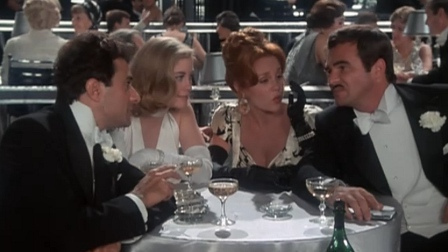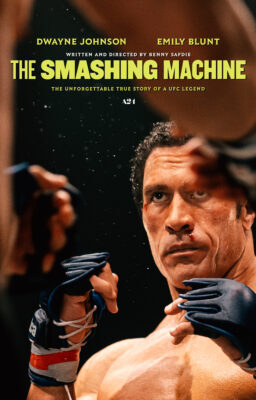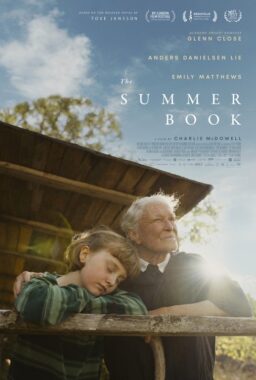It is a story almost as old as the cinema itself. In the wake of a string of enormously successful past enterprises, a filmmaker is given the chance to make practically any film that they want by studio heads who are absolutely convinced of their commercial infallibility. Alas, things begin to go wrong, the production begins to spiral out of control by going over-schedule and over-budget and when it finally gets released, it lasts just long enough in theaters to be slaughtered by the critics (who wind up spending more time reviewing the budget than the movie itself) and ignored by audiences before disappearing into obscurity. Then, many years down the line, that very same film is rediscovered and embraced by a new generation of critics and viewers who are far enough removed from all the negative hoopla to judge it on its own terms.
The list of projects that fit this description is long: John Carpenter’s remake of “The Thing,” Michael Cimino’s notorious 1980 neo-Marxist western “Heaven's Gate,” William Friedkin’s nerve-wracking 1977 “Sorcerer.” Even the infamous 1987 flop “Ishtar” is seeing a long-overdue reversal of its fortunes as more and more people are finally beginning to recognize it as one of the funniest American comedies of its decade.
Despite all that, if someone had predicted a few months ago that 2013 would see a reappraisal of Peter Bogdanovich‘s musical “At Long Last Love,” most observers would have laughed off such a suggestion as pure lunacy. Actually, most people would have furrowed their brows in confusion because unless they were regular moviegoers in 1975, it is unlikely that they would have even heard of the film. This was not just a run-of-the-mill failure; this was the kind of flop that hobbled entire careers before disappearing so completely from view that unless you were a 20th Century Fox stockholder, it was possible to believe that it never actually existed. The film was never accorded a home video release in any format (though it would make the odd appearance on cable every once in a while) and if it had any contemporary cachet from anyone other than hardcore cineastes, it came from serving as a punchline in a very funny Burt Reynolds-centric episode of the animated cult comedy series “Archer.”
And yet, more than 38 years after its original release, “At Long Last Love” is finally getting another chance thanks to the arrival of a Blu-Ray release containing a restored version of the film and a backstory involving its return that is wild enough to potentially inspire a movie of its own one day. Does this new presentation reveal the film as a tragically overlooked masterpiece that is finally getting its due? Maybe not, but it does show it to be a film largely undeserving of its reputation as an unmitigated bomb. In fact, much of it is a cheerful delight made with a lot of style, energy and unabashed fondness for the history of the movie musical, and many of the elements that were once dismissed as flaws now come across as strengths. It may not be perfect but in terms of sheer entertainment value, I would take it over most any of the live-action musicals that have come out in the last decade or two in an instant, if only because it has a sense of genuine fun that is lacking in most current film musicals.

Using sixteen songs by the great Cole Porter — running the gamut from classics like “Let’s Misbehave,” “You’re The Top” and “I Get A Kick Out of You” (a tune which had received a cinematic revival of sorts a year earlier when turned up as one of the more inspired punchlines in Mel Brooks’ “Blazing Saddles“) to lesser-knowns like the title song (a composition supposedly cursed since Porter was said to have composed it to take his mind off the pain while waiting for help following a crippling riding accident) — as a through-line, “At Long Last Love” tells a gossamer-thin story involving a quartet of impossibly attractive people falling in and out of love with each other. Burt Reynolds plays an impossibly wealthy and charming playboy/bon vivant, Madeline Kahn plays a stage actress, Cybill Shepherd plays an heiress, and Duilio Del Prete plays a hunky gambler.
After comical introductions, the four become virtually inseparable — even Shepherd’s chaperone (Eileen Brennan) and Reynolds’s valet (John Hillerman) get into the act as she begins to pursue him — as they glide through a life filled with lavish parties, endless glasses of champagne and musical numbers that crop up at the drop of a top hat. Frothy romantic mix-ups ensue. By the time it all wraps up, pretty much everyone winds up with exactly the person they deserve and even the chaperone and the valet get in on the happy ending.
Although “At Long Last Love” is often described as a simple pastiche of the musicals of the 1930s, especially the classics featuring Fred Astaire and Ginger Rogers, what Bogdanovich does here is a little more complex than that. If he had offered a simple revival of that style of filmmaking as he did three years earlier with his screwball comedy homage “What’s Up Doc?”, the end result might have wound up playing better with critics and audiences at the time. Instead, he has fused together two distinctly different musical movie approaches — the lighter-than-air confections of the ’30s with the slightly more grounded and realistic style utilized a decade or so later by the likes of Vincent Minnelli — and while the resulting combination may have thrown viewers back in the day, it not only plays quite well nowadays, it actually feels more modern than most of the current efforts in the genre.
From the ’30s, Bogdanovich’s inspirations are mostly of the technical variety. Although he had great success in utilizing black-and-white cinematography in his hits “The Last Picture Show” (1971) and “Paper Moon” (1973), Bogdanovich, perhaps as a commercial concession, wound up shooting “At Long Last Love” in color. But he cleverly managed to replicate the effect of black-and-white using production design.
More controversially, he decided to eschew the standard method for shooting musicals — having the performers pre-record their vocals and then lip-synch to those tracks during the actual shooting — by going back to the way that it was done in the old days, having the performers actually singing their songs live as the cameras rolled. If this technique sounds familiar, it is because the recent “Les Miserables” utilized the exact same approach, though few of the articles praising that film for its so-called innovation bothered to cite Bogdanovich for doing it decades earlier.
While the technical matters might have been straight out of the ’30s, Bogdanovich also took inspiration from the more emotional and dramatically centered musicals of a later era and decided that the best way to achieve this kind of effect was to cast people who weren’t trained as singers or dancers in the leads; only Kahn had any real training in those areas. The idea, as far as I can tell, is that what their efforts might lack in skill and finesse, they would gain in a sense of realism, with the lack of polish suggesting what might occur if real people were to suddenly burst into song and dance as a way of expressing their feelings. To cast an elaborate musical with people who were not exactly renowned for their singing and dancing abilities was an enormous gamble by itself, but Bogdanovich doubled down by asking them to perform their numbers live. Many observers felt that Bogdanovich was biting off far more than he could possibly chew and indeed, when it was released, those two decisions tended to be the main focus of the brutally bad reviews that the film received. (Woody Allen, who has spoken of his fondness for the film, would use it as an obvious influence on his own underrated musical extravaganza, “Everyone Says I Love You” (1996).)

With the controversies surrounding its approach having long since faded away, it’s actually quite winning and whatever the performances lose in technical polish, they more than make up for in other areas. The best performances come from the seasoned pros Kahn, Brennan and Hillerman — even the nastiest reviews back in the day usually singled them out for praise — but they have been given the scene-stealing roles and proceed to do just that with gleeful abandon. As the hunky crooner, Duilio Dul Prete doesn’t exactly set the world on fire but he does an adequate job of doing what the straight romantic leads in the later Marx Brothers movies were asked to do — look handsome, sing passably and not steal too much focus from the leads. Because she was dating Bogdanovich at the time and had already worked for him in “The Last Picture Show” and the underrated Henry James adaptation “Daisy Miller” (1974), Cybil Shepherd was singled out for withering scorn regarding her singing and dancing abilities, but I have to disagree. Her singing is perfectly decent (she would go on to record a couple of albums in later years that received some acclaim) and while her on-screen persona is perhaps a bit chillier than one might ordinarily see in this type of film, it adds enough of a tart edge to the proceedings to keep things from becoming totally frivolous.
The only performance that is a bit of a miscalculation is the one turned in by Burt Reynolds and that isn’t so much a problem with what he does — he is funny and charming and if I had to pick a Burt Reynolds musical, I would take this over “The Best Little Whorehouse in Texas” (1982) in a heartbeat — as much as it is an example of miscasting on Bogdanovich’s part. Fred Astaire and Gene Kelly are arguably the greatest male leads in the history of American musical cinema. Part of the reason for their success is that neither one was quite the classic movie star type — Astaire always looked a little gawky while Kelly had the kind of everyman look that wouldn’t really take hold in the industry for a while — and it therefore made sense that they would need to use their considerable singing and dancing abilities to make up for their deficiencies in other areas.

Reynolds, on the other hand, was a bona fide movie star in the mold of Cary Grant — suave, debonair, funny, and catnip for the ladies. By assuming a Grant-like approach within a musical-comedy context and without the offbeat quality of Astaire or Kelly to reduce the whimsy, Reynolds is so overly light and charming that at times he practically floats off the screen. I have a sneaking suspicion that if Bogdanovich could somehow magically go back in time and redo the film, he might recast this role. (As it turns out, after briefly flirting with the idea of playing the role himself, Bogdanovich initially offered the part to Elliot Gould; in hindsight, he probably would have been a better choice.)
Other than that, “At Long Last Love” plays so well today in so many ways that it almost feels as if those who lambasted it back in the day must have seen a different movie. As it turns out, that is indeed pretty much the case. In an article for Indiewire that anyone intrigued by the film should read, Bogdanovich tells of how, in the wake of a couple of unsuccessful preview screenings, he grudgingly agreed to do a lot of last-minute editing just before it had its premiere at Radio City Music Hall. Alas, this cut proved to be even less impressive than the others and it was this version that inspired all the vitriol. As the story goes, Bogdanovich asked for the chance to make a few more changes for its television version at his own expense and while he was allowed to make them, they were not enough to change its fortunes. In fact, after its release, Bogdanovich took out full-page ads in newspapers across the country apologizing for the film.
A couple of years ago, the film popped up on Netflix Instant and when Bogdanovich sat down to watch it, he was stunned to discover that this was not the version that bombed so badly back in 1975. In fact, it seemed to be a much more refined version of the original cut that he turned in before that last-second recut. As it turns out, a veteran employee of 20th Century Fox’s editorial department — who was also a huge Cole Porter fan — took it upon himself to surreptitiously repair the damage that had been done to the film, and it was this version that had been making those occasional broadcast appearances since 1979 and amassing a small but devoted cult over the years without anyone realizing exactly what it was. Technically, this was a big no-no because Bogdanovich had the right to final cut in his contract, but he loved it so much that it is this version — cleaned up further and with a few additional tweaks — that now stands as the definitive version of the film for its Blu-Ray release.
In terms of his directorial career, all of this latter-day acclaim for “At Long Last Love” may be a case of too little too late for Bogdanovich. Once one of the hottest directors in Hollywood, its failure more or less single-handedly destroyed his directorial career and while he would have the occasional critical success (such as “Saint Jack” (1979) and “The Cat's Meow” (2002) and even a popular hit in 1985 with “Mask,” he would never again reach the heights that he once achieved so effortlessly in his earlier days. (That said, he would find latter-day success as an actor in things like “The Sopranos” and as one of America’s most erudite film historians — his epic-length interview book “Who the Devil Made It?” should be required reading in every cinema history class.) Whatever its failings may have been in financial terms, “At Long Last Love” is an artistic success through and through and it is nice that new generations will finally get a chance to recognize its charms so that it can finally have its long-overdue and wildly appropriate happy ending.
Read Donald Liebenson’s interview with Peter Bogdanovich here.












